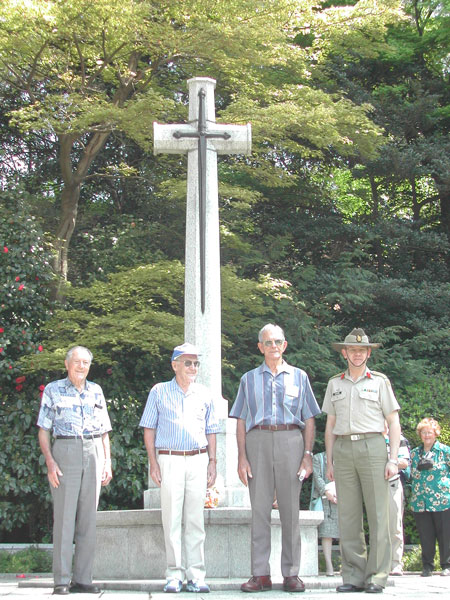| Testimonies of POWs |
Experiences of Neil MacPherson
Experiences of 19 year old Neil MacPherson, an Australian soldier captured in Java in March 1942, he was to spend nearly 2 years in Burma & Thailand working on the death Railway that cost the lives of over 12,000 of the 60,000 POWs.
In September 1942 under the command of our legendary Pioneer Battalion C.O. Lt Colonel Williams, 1800 prisoners from Java were shipped to Burma in conditions that today we would not allow sheep to travel. This involved three separate journeys in three Hell Ships, the Kenkon Maru, Maebashi Maru and Yamagata Maru
Arriving in Thanbyuzayat in October 1942, we joined the first of Brigadier Varley's A Force of Australians just arrived from Tavoy, with them we were the first Australians to start work on the Burma Thailand railway.
The next Australians, arrived in Burma, in January 1943, also from Java, No 5 Group, the first Australians to commence work on the Thailand end were also from Java, Dunlop Force in January 1943
The following 15 months were to test the metal, the morale, and the Anzac spirit of the Australian prisoners in Burma.
We labored on a starvation diet of a hand full of rice and watery usually meatless stew, clearing the jungle, on embankments, on cuttings, on bridges in the heat of the dry, and the misery and slush of the wet then, we survivors, along with the remnants of Lt Colonel Anderson force, were selected as No 1 Mobile Force, to carry out the arduous and demanding task of laying the sleepers and rails, along our previously worked ground.
We worked continually through the wet, from Thanbuzayat right through into Thailand where the two ends were joined on 17th October 1943 a distance of 131 kilometres from the start
Our clothes and footwear, long destroyed in the fetid jungle, left our only protection from the burning heat and the rain, a loin cloth. Bed bugs and lice left by native workers made for harrowing and restless nights, from the start deaths were continuous and as our numbers dwindled so our work hours grew
With no drugs whatsoever, malaria, dysentery, beri beri, pellagra, tropical ulcers, smallpox, and finally cholera took its toll. The dedicated Doctors and medical staff were supermen, working with make shift tools, without them our losses would have doubled
Our torment continued till January 1944 when the survivors, wrecks of men, in rags, staggered out of their jungle camps to be transported to the well organised better-equipped camps in Tamarkan & Kanburi in Thailand
Despite a continueing death rate from the results of our ordeal, after six months of improved food and lighter work we survivors regained some semblance of health, little did we know that this was part of a well designed plan by our captors.
Thousands of Railway workers, Australians in a majority were selected for shipment to Japan as slave labour, to work in mines, factories and on the docks. Thousands of them were to die in Hell Ships sunk by US submarines.
My luck as a survivor continued, I was on the last ship, the Awa Maru, my fourth Hell Ship, to successfully make the journey. We arrived in Japan in January 1945, the coldest winter Japan experienced in 40 years, to spend the remaining months working in a coal mine
An unknown author described conditions on board these Hell Ships thus
"Crowded onto cramped platforms, with barely enough space to turn around, a mass of unwashed bodies struggling to survive in a sea of sweat and revolting smells in the stifling heat of the holds. Initially in the tropical heat near the equator, but the ensuing month was to see us making our way across snow covered decks for our l toilet functions"
The following report which I wrote for an Australian Ex POW Magazine may also be of interest
MP 24 SENDYU KYUSHU JAPAN
On the 15th December 1944, 545 Australian prisoners from River Valley Road camp boarded the Awa Maru in Singapore harbour, all had been selected from the survivors of A. Force on the Death railway. After 11 days battened down under scorching decks the vessel sailed for Japan Boxing Day, on the 15th January 1945 the prisoners staggered ashore at Moji, northern Kyushu, mid winter, snow on the ground.
150 of the group including 34 Americans, travelled to Senryu on the north west coast of Kyushu, after several days of training by Japanese miners they were classified fit to work in the Sumitoma owned coalmine. Compared to the, horrors, death, disease, squalid conditions and brutal treatment on the railway conditions at camp 24 were 5 star, comfortable warm huts, 12 to an airy room. Apart from petty harassment by the guards, insufficient food to sustain the long shift in cramped and hazardous conditions underground the moral was excellent.
The miners under whom we worked were helpful in teaching the prisoners how to survive in this dangerous environment, and unlike other work areas no punishments were handed out. Towards the end their lunch boxes contained very little more than the prisoners. On the 16th August 1945 we were paraded and told "the order had been given to stop the fight", in due course the prisoners took over the camp, supplies dropped by US bombers made the next 5 weeks a pleasant memory. Hikes into the surrounding countryside, invitations from farmers to visit their homes, sharing scarce food, prisoners in turn sharing the bounties from the US planes are pleasant memories.

|
|
|
Left to right; Jack Boon, Niel MacPherson and Military Attache of Australian Embassy |